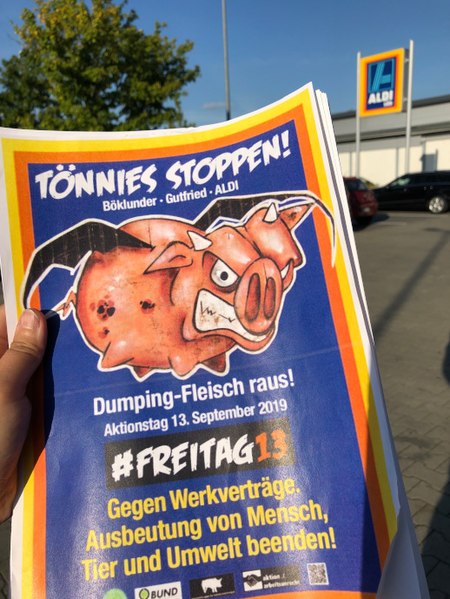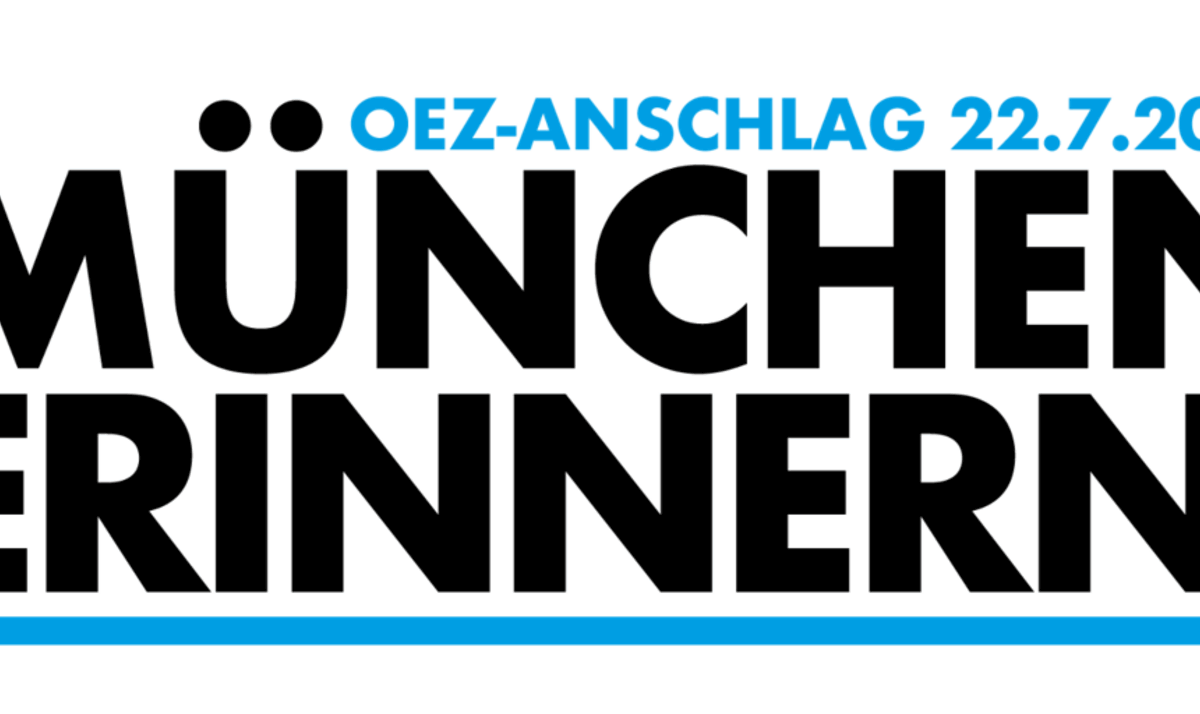Meat: the pandemic has thrown an industry that’s hid from the public eye for decades into the spotlight. In Germany, serious outbreaks of COVID-19 at a number of meatpacking plants have drawn attention to cramped company-provided living conditions and unsanitary workplaces. In the United States, where 60,000 workers have become infected with COVID-19, the meatpacking company Tyson came under fire after management at one plant was found to be taking bets on which of the workers would contract coronavirus. And according to virologists, the conditions in the plants themselves are also perfect for the spread of the virus – cold, cramped, and stressful. All the attention the industry has received resulted in tangible changes for slaughterhouse and meatpacking employees, but the changes are not enough to fix the rampant problems that jeopardize the health of the animals, workers, and end-consumers eating the meat.
The fact that these workers have been some of the hardest hit by the pandemic should come as no surprise, as working in a slaughterhouse or meatpacking plant is one of the most dangerous jobs there is. The speed of the line on which workers dismember animals is mind-numbingly fast. In Germany, 1,300 birds, 110 pigs and 7 cows are slaughtered every minute [1]. Each worker in the line makes a few cuts to the meat, meaning that they make the exact same motion for the entirety of their shift, which can last up to 12 hours. Chilled air to keep the meat fresh leads to numb fingers and an extremely high number of knife and saw accidents. Workers stand close to each other in order to maximize efficiency. Maintaining distance all but impossible.
Isn’t this scale of production necessary to feed our population? Yes, and no. Meat comes from animals, and those animals need to be killed. But the industry is hyper-capitalist: focused on profit-maximization while at the same time deliberately hiding from the public eye. For the purpose of this article, I will save a discussion of the negative environmental impacts of industrial agriculture (including its role in rising antimicrobial resistance and the emergence of new zoonotic diseases) for another time to focus the workers and the relatively recent change in how meat makes its way from walking around to your plate.
The location and function of slaughterhouses have changed dramatically since the era of Upton Sinclair’s The Jungle, a book that brought the harsh conditions of the slaughterhouses in the Chicago stockyards to light. Located in meatpacking districts of large cities to reduce travel distance, slaughterhouses were unsightly places, yet still very much in the public eye. Union membership was very common, and the workers were well paid, with wages above the average manufacturing wage in the United States. While the job was both physically and psychologically challenging, workers could strike for better conditions and wages with the backing of the unions [2]. Following technological advances within the slaughterhouses and in refrigeration, the situation changed dramatically. The industrialization of slaughterhouses resulting from these developments was called the “IBP revolution”, after Iowa Beef Processors (IBP), a meat packing company that is now a subsidiary of one of the largest meat multinationals in the world, Tyson Foods, Inc.
The changes were spearheaded in the 1960s by IBP’s development of boxed beef, a vacuum-packed product resulting from the removal of fat and bone from a carcass, which made transporting meat over long distances much cheaper and easier. Since the transport of live animals was no longer required, it became more efficient to slaughter in a single location close to the feedlots and transport the meat to consumers afterward. The slaughterhouses therefore moved out of the urban centers to rural areas, allowing for easier access to the supply of animals as well as opportunities for expansion of the facilities. Soon after, new industrial feeding operations developed close to the slaughterhouses to reduce their own transport costs [3,4].
After changing the location of the slaughter, further cost reduction focused on maximizing economies of scale through technological advances within the slaughterhouse itself. The focus changed to simplifying the slaughtering process by using a “disassembly line” instead of having skilled butchers slaughter one animal at a time. This disassembly line relies on a conveyor belt and breaks down the slaughtering/ packing processes into single, repetitive movements, greatly increasing the number of animals slaughtered per hour. Once the nature of the required labor changed, IBP used this “deskilling” to justify paying lower wages and recruiting from a wider labor force. The reduction in costs was so significant that other companies were forced to do the same to compete.
The change in the nature of the slaughtering process created an industry that was no longer forced to rely on skilled union labor and could instead recruit from a wide pool of low-skilled workers. The barrier to this recruitment was that the move from urban centers to rural areas placed the plants in towns without a large supply of workers. The slaughterhouse companies had to recruit outside of the communities, to which immigrant labor presented a good opportunity [5]. Companies started targeting their recruiting efforts specifically to immigrant communities, from workers on the U.S. – Mexico border, to refugees from the Bosnian war. In general, employing “foreign” (from outside the community) workers is beneficial to a company, as it discourages communication between laborers and with the surrounding community that could lead to strikes. This is a tactic that has been widely used around the world to reduce workers’ abilities to organize.
A similar trend of industrialization within the slaughterhouse also occurred on the European continent. In Denmark, home to one of the largest pork producers in the world, Danish Crown, the number of independent, cooperatively organized slaughterhouses fell from over 80 to two (of which Danish Crown is one) [6]. In Germany, the change can be seen in the number of animals that are slaughtered on farms. In 1993, over 1.2 million animals were killed by individuals instead of by companies. By 2017 that number had decreased to 80,000 [7]. And the deskilling of slaughterhouse work has opened up the industry to low-wage immigrant labor, similar to the situation in the United States and Canada.
When ten Eastern European countries joined the European Union in 2004, it opened up the possibility for them to exchange labor with E.U. members. Legislation was already in place to allow the free movement of workers contracted for specific jobs (Werkvertragsabkommen) and exchange of services (EU-Dienstleistungsfreiheit) throughout the European Union, which allowed laborers from Eastern Europe to travel to Germany for employment. Since wages are lower in Eastern Europe compared to Germany, people from Poland, Hungary, Romania and Bulgaria have historically been interested in finding employment outside of their home countries [8].
Slaughterhouses in Germany began to take advantage of this supply of labor, except instead of recruiting employees directly they did so through third-party contractors, using a system that was already in place within the German construction industry. The company in Germany employed a recruiting firm, often in a different country, which was responsible for finding workers and transporting them to Germany. The workers would then be supplied with housing, given jobs at slaughterhouses, and work for minimum wage. This production that relies on the low-wage labor of groups without a foothold in a country is what has allowed industry profits to skyrocket.
Tönnies, the largest slaughterhouse company in Germany, combined with Vion and Westfleisch accounts for more than half of the slaughtering in Germany [9]. All operated (prior to 2020) through this system of third-party contractors – at one Tönnies plant in Rheda, Germany, over half of the workers were not employed by the company itself. The explosion in cases at the slaughterhouses (until the end of October, a contract employee was eight times more likely to be infected with corona than the rest of the population), along with the companies’ inability to provide an address of record for their contractors, led to a new law that came into effect on January 1, 2021. Under this law, people who work in meat processing plants need to be employed by the company, which should in theory change the way that meat processing operates in Germany.
Unfortunately, according to interviews conducted by the Süddeutsche Zeitung, this doesn’t seem to be the case. The workers are doubtful the third-party companies will leave the picture, and even those who were already officially employed were never paid more than 10 euros per hour for their work. A bed in a ten-person room costs them 250 euros per month. And the conditions inside the slaughterhouses remain the same: fast-paced, dangerous work in the freezing cold. A workforce that is actually employed by the slaughterhouse companies will clearly benefit the workers, but won’t be enough to deeply change this massive, problematic industry.
The barrier to change is that consumers have have gotten used to extremely cheap meat, but consumers aren’t benefitting from it nearly as much as the companies are. In an interview with the Wissenschafts Zentrum Berlin für Sozialforschung, Matthias Wolfschmidt of Foodwatch said, “the large business groups determine the prices with their market power – at the cost of farmers and the animals. Even if meat in the supermarket weren’t 1.99 euro and instead twice as much, the profit margin of these groups would continue to rise under the current conditions.” [10]
Consumers don’t get a bargain because the system is working so well; the low price of meat reflects an industry that puts the health and well-being of animals and people in jeopardy in pursuit of profit. A German farmer is paid on average 150 Euros for a whole pig, and one fifth of the pork processed in Germany is slated for export [11]. Radical industry-wide change is needed, and that starts with highlighting the problems. The pandemic provided a start, but there’s much more to be done.
Footnotes
1 Ellguth, Paula/Fels, Marjam/Friedrichsen, Jana/Hamdan, Jana/Huck, Steffen. “Nicht-Orte der Fleischindustrie. Fakten und Hintergründe zum Schlachten in Deutschland.” (2018)
2 Broadway, Michael. “Meatpacking and the Transformation of Rural Communities: A Comparison of Brooks, Alberta and Garden City, Kansas.” Rural Sociology 72, no. 4 (2007)
3 Fitzgerald, Amy J. “A Social History of the Slaughterhouse: From Inception to Contemporary Implications.” Human Ecology Review 17, no. 1 (2010).
4 Stull, Donald D., and Michael J. Broadway. “Slaughterhouse Blues: The Meat and Poultry Industry in North America.” 2nd ed. Case Studies on Comtemporary Social Issues (2013).
5 Dillard, Jennifer. “A Slaughterhouse Nightmare: Psychological Harm Suffered by Slaughterhouse Employees and the Possibility of Redress through Legal Reform.” SSRN Scholarly Paper. Rochester, NY: Social Science Research Network (2007)
6 Bjarke Refslund. “Offshoring Danish Jobs to Germany: Regional Effects and Challenges to Workers’ Organisation in the Slaughterhouse Industry.” Work Organisation, Labour & Globalisation 6, no. 2 (2012)
7 Ellguth, Paula/Fels, Marjam/Friedrichsen, Jana/Hamdan, Jana/Huck, Steffen. “Nicht-Orte der Fleischindustrie. Fakten und Hintergründe zum Schlachten in Deutschland.” (2018)
8 Heinrich Böll Stiftung, “Der Fleischatlas 2016 – Deutschland Regional”
9 Ellguth, Paula/Fels, Marjam/Friedrichsen, Jana/Hamdan, Jana/Huck, Steffen. “Nicht-Orte der Fleischindustrie. Fakten und Hintergründe zum Schlachten in Deutschland.” (2018)
10 Ibid.
11 Ibid.




